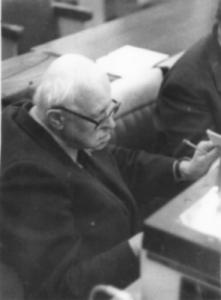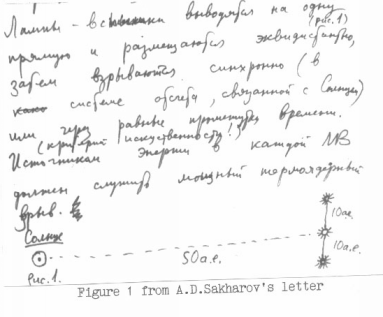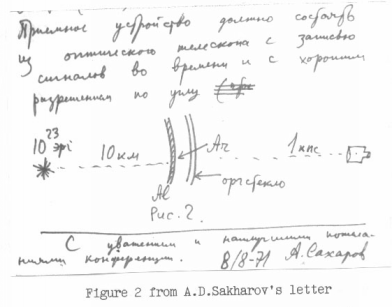ANDREI DMITRIYEVICH SAKHAROV AND SEARCH FOR EXTRATERRESTRIAL INTELLIGENCEL.M.GINDILISSternberg Astronomical Institute, Moscow State University, 13 Universitetskij prospekt, Moscow V-234, 119899, U.S.S.R.ABSTRACT: The complete text of A.D.Sakharov's letter of August 8, 1971, concerning his ideas on Search for Extraterrestrial Intelligence, is published. Comments on the historical background of the letter are given. This publication appeared in the Russian in Zemlya i Vselennaya (The Earth and Universe), 1990, No.6, p.63. ((c): Nauka Publishers, Moscow, 1990). Translated from the Russian by G.M. Rudnitskii.
In 1971, when preparing the Soviet-American CETI Conference, the Organizing Committee developed a questionnaire aiming to sound the opinion of scientific community on some main items of the SETI problem. The questionnaire was sent to the supposed participants of the Conference as well as to the scientists whose opinion seemed to be of interest to the authors of the questionnaire. In total, 64 questionnaires were distributed and 37 replies (58%) received. Among those who sent the reply was Andrei Dmitriyevich Sakharov. Some quotations from the replies were published in the review Zemlya i Vselennaya (The Earth and Universe), 1972, No. 4. It was envisaged to publish a more detailed article in the Appendix for the Russian edition of the Conference Proceedings (CETI Problem: Communication with Extraterrestrial Intelligence. Mir Publishing House, Moscow, 1975). Dr. S.A. Kaplan and I, we prepared a large article which was accepted by the publishers. However, by the moment of publication of the Proceedings, Andrei Dmitriyevich's activities in the domain of human right defence reached already such a scale that mentioning his name in publications was considered as undesirable. We were advised to delete the corresponding portions of the text; we refused to do so, and the article was never published. All these years, I have been conserving Andrei Dmitriyevich's letter. The questionnaire contained ten questions. Andrei Dmitriyevich answered four of them. They are as follows.
7. What is your opinion on the necessity of international cooperation in the field of SETI:
b) coordination of SETI works.
Dear L.M. Gindilis,
I express myself only on three items of the
questionnaire - 10, 6, 9, 7 *) and I ask you to forgive
my incompetence both on these points and the ones
which for this reason remained unanswered.
*) Thus it is in the text. Probably, Andrei Dmitriyevich was intending to answer three questions, but later added one more.
6. Proceeding from the importance of the problem and, at the same time, taking account of the fact that we probably are not quite ripe in the sense of science and technology for the solution, I consider as advisable the following solution of the money problem. During the next 5 to 10 years, the expenses for dedicated SETI studies should reach the level of 5% of the total amount spent for astronomy and astrophysics, including into the latter space-based astronomical and astrophysical investigations. Simultaneously, a program of "shared" studies should be discussed and adopted, with the main aim of these studies being not connected with SETI but the data processing and the observational system taking SETI interests into account. This is an eye estimate which is all the more valuable, since I do not know what the 100% are equal to in the USSR, the USA, the whole world. 7. International cooperation in the realization of projects is desirable. It is also desirable to raise the question of the development and adoption of an international agreement requiring an immediate (say, within a week or a month) publication of any facts suspected as a signal of an extraterrestrial civilization, prior to its detailed study by means of national activities. 9. Science and technology of the business. It cannot be completely excluded that we know too little and can do too little. It cannot be excluded that there are crying gaps in our basic ideas on space, e.g., on its topologic structure, and that extraterrestrial civilizations make their transmissions with an account for this circumstance, while we "are looking in the wrong direction". We cannot exclude also crying gaps as far as the types of radiation existing in the nature are concerned. It is still more probable that our correspondents, using the kinds of radiation and the laws of nature already known by us, count thereby upon a level of sensitivity of the receiving devices which is yet completely inaccessible for us due to technical, technological and economic reasons. However, all these doubts ought not to damp our ardour on the way of attempts of signal reception with a gradual increase of sensitivity (and cost) of the receivers and with an expansion of the search methodology. It is only on this way that we can hope for a success, sooner or later. Thereby I would like to stress the importance of designing works on sending signals, these works being led to a concrete realization of some projects - it is only in this way that one can understand delicate aspects of the contact problem. Here, as in other kinds of business, egoists are after all the losers. 9a. I want to discuss briefly a concrete version of the communication system. Once per 10-20 years, several single-action sources of signal (flash lamps, or FL) are moved outside the solar system, to avoid the blinding effect of the Sun. Flash lamps are placed along a straight line and equidistantly spaced (Fig. 1) and thereafter are exploded synchronously (in the reference frame connected with the Sun) or after equal time intervals (the artificiality criterion!). The source of energy in each FL should be a powerful thermonuclear explosion.
The energy of the explosion is readily transformed into a short flash in the light spectral region, at microwaves, etc. Certainly, the dimensions of the FL system must be rather impressive (of the order of kilometers) but the weight is not great. For instance, if we compress by the energy of the explosion products a thin layer of gas (argon), we can easily obtain a very short flash in the visible light, thereby with any microstructure for transmission of information (Fig. 2).
A receiving device should consist of an optical telescope with a time record of signals and with a good angular resolution. With respect and best wishes to the conference
Almost two decades have elapsed since the day when these lines were written. It is not a short term for our dynamic age. Let us try to look at A.D. Sakharov's answers from the present-day viewpoint. To me it seems significant that Andrei Dmitriyevich started with the last question - the one on possible consequences of a contact. As a Citizen of the World, he was interested by this question in the first place. It should be mentioned that during the la[Ast years this problem in an ever growing measure is attracting the scientific community's attention. This problem has become a subject of dedicated discussions at several SETI meetings, organized jointly by the International Academy of Astronautics and the Space Law Institute. A project of an International Agreement has been developed; this agreement must regulate the activities of individuals and institutions in the case of an ETI signal detection. The problem of publication has also been seriously discussed. The specific character of a SETI positive result is in that such a result would affect the interests of not only a particular group of scientists but of the whole mankind and could have a serious impact on the development of the terrestrial civilization. Nevertheless, experts in space law came to a conclusion that a broad publication about an ETI signal detection is necessary in any case. Thus, Andrei Dmitriyevich Sakharov's ideas gradually find their realization and development, although they did remain for a long time unknown to the scientific community. I would like also to draw the reader's attention to the Andrei Dmitriyevich's idea on a gradual receipt and gradual perception of information. In fact, the reception of information from ETI is often considered as a one-moment act of signal detection and decoding. This sudden detection may lead to acute social consequences, the more serious ones the less are we prepared for such a discovery. Meanwhile a similar model of a contact is quite unnecessary. The contact may be not a discrete act but a long process, involving several generations. In such a prolonged process, the social acuity of the contact is smoothed. The main result of a contact with Extraterrestrial Intelligence, according to A.D.Sakharov, would be an expansion of our horizon, overcoming the anthropomorphism, refinement of ethical and social relations. It is interesting to note that these ideas of A.D.Sakharov are within the main flow of the Weltanschauung ideas of the Russian cosmism and "Live Ethics", as well as Sakharov's clear perception that, by any circumstances the fate of the mankind is finally determined by its internal state. Of importance seems to be also Sakharov's remark on the "shared" investigations. By the present time, about 50 SETI experiments have been carried out all over the world. None of them has succeeded so far. This is quite explicable and even inevitable. It would be naive (moreover, it would be a great error) to count on a quick and easy success in the solution of such a grandiose problem. However, obtaining continuously only negative results creates an extremely unfavourable psychological atmosphere. To overcome this situation, the investigations must be organized in such a way that, besides SETI, some astrophysical problems be solved. Then, even in the absence of signals, the experiment results will not be negative. Many scientists now take account of this circumstance and try to plan their research just in this way. Even a special term, "shared" (or "parasitic") search, has emerged. Although Andrei Dmitriyevich never took part himself in SETI, he saw rather keenly the above-mentioned trouble and indicated the right direction. In the discussions on the SETI problem, the attention was more than once drawn to the possibility of existence of communication channels basing on the unknown by us laws of the Nature and of unknown signal carriers. In this connection, doubts were expressed as to the rightfulness and expediency of the signal search at microwaves (or in other ranges of the electromagnetic waves spectrum). A.D.Sakharov also noted the limited character of our knowledge and the possibility of existence of other signal carriers; he stressed, however, that this fact ought not to cool our ardour and to be a pretext for cessation of SETI experiments. During the first years of the formation of the SETI problem, the main accent was placed on signal detection (reception). This trend is conserved till now. A.D.Sakharov paid attention to a necessity of combining the search with the transmission of signals. Later, first steps in this direction were made. In 1974, a message to ETI (towards the globular stellar cluster M 13) was sent from the Arecibo Radio Observatory. The information plaques and containers mounted on the space vehicles PIONEER 10 (1972), VOYAGER 1 and 2 (1977) can be classified here as well. Certainly, these attempts should not be considered for our part as serious efforts towards establishing a contact with ETI. But these are just the experiments without which, as indicated by A.D.Sakharov, it is impossible to understand "delicate aspects of the contact problem". This is not by chance that one of the authors of the VOYAGER message, Jon Lomberg, wrote: "And even if the records are never found, they have given us good practice in imagining and anticipating what a message from space might be like, if SETI succeeds". For specialists of interest probably would be the proposed by A.D.Sakharov method of optical signalization by means of a nuclear flash lamp. With modern telescopes, such a flare could be detected at a distance of nearby stars. For registration of ultrashort light pulses, can be used the systems similar to the MANIA equipment, developed in the Special Astrophysical Observatory of the USSR Academy of Sciences under the direction of V.F.Shvartsman just for SETI at optical wavelengths. The reader has perhaps noted that Andrei Dmitriyevich suggested to move several nuclear charges outside the solar system and to explode them there systematically, once per 10 to 20 years. Of course, were this project ever realized, an appropriate international agreement on security measures during placing these charges into orbit would be required. If the security conditions are observed, this would be a good way to get rid of nuclear weapons on the Earth. Isn't this A.D.Sakharov's project an example of a shared experiment in which two interconnected problems would be solved - nuclear disarmament on the Earth and communication with Extraterrestrial Intelligence? |


